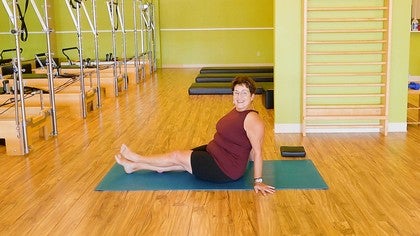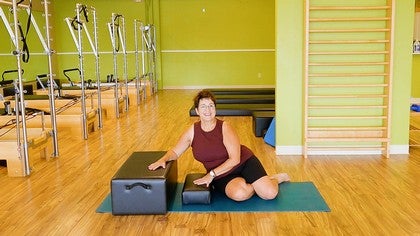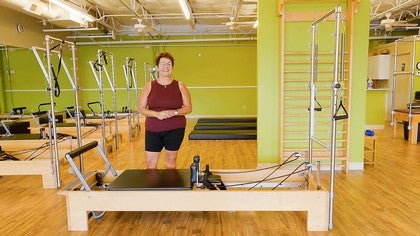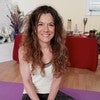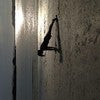Description
About This Video
Transcript
Read Full Transcript
Hi, my name is Karen. And thank you for joining me at Pilates Unlimited for some fascial flexibility. We're gonna use a little pinky ball today, and we're gonna use it in different ways. As we start, I want you to take the ball and just start tapping the ball on all of your muscles. In this session there aren't any rules and isn't that a good thing, because we don't always need rules to make things happen.
We're talking about the fascial system, the myofascial system, meaning the muscles with the fascia, and just keep tapping your arms all the way down. Some of you might have done this before in other classes. We're just providing a sensation. And then if you remember from past ball rolling or foam rolling, sometimes you start to feel an increase in flexibility when you put the ball in different areas. And that's because our fascia has different cells that respond to different kinds of input.
So you're gonna take the ball now and just put it underneath one of your feet. Mine is underneath my right foot. We've all done this at some point. You're gonna pump your foot down on the ball and maybe start to step your other leg forward and your other leg back. All's you're looking for here is a sensation.
We're loading our system by putting the weight directly into the ball over our foot. There are some other neuromuscular things and central nervous system things that are happening up through our foot as we do this. Let's do two more times and back. And then last time go forward and then come back and just pause right there. The concept that I want to work with today is called locate, load and move.
I'm gonna say that again, in case you wanna write this down, it's called locate, load and move. This is something that I have found very beneficial for myself. And what we're doing now is I'm locating a place of sensation, not big restriction, I'm not looking for massive amounts of pain, so I'm locating that spot. And so now I have the spot underneath my foot somewhere. Your spot may be different than mine.
I located it, I feel it. Now I'm gonna load it by maybe shifting my weight forward and just loading it. I'm loading it with my thigh and my body muscle. That's locating it and I loaded it and now I'm gonna move. So I'm gonna move maybe my other leg, or maybe I'll move by bending this knee, or maybe I'll move by hip hinging forward and back because that movement, maybe over to the side, maybe back behind me, that movement will provide that like 360 degree feedback to my body.
Now, same leg. Find another spot. Maybe take a second and, and take that ball out, maybe roll it a couple times. We've all done different types of rolling, different kinds of methods. Just roll that out like cookie dough and then find another spot.
I'm gonna find another spot that is just anterior to my heel. It's a sensation. I'm not looking for extreme pain. Although sometimes you might feel some discomfort. I've located the spot and now I'm gonna load it.
I'm gonna bring, see I get the max load. Now my legs a little bit closer together. And the movement this time for me is telling me that I wanna do some ankle motion. So now, because now I feel some restriction from my heel, maybe to the front of my ankle. So I've located it.
I've loaded it. And now I'm calling for movement somewhere. What if I come down here and I call for the movement in my big toe. And I just pick my big toe up with my other hand. That is still movement.
What if I take my foot like I've got chewing gum on my heel and that's the movement. Locate, load and move. We did two times on the right foot, let's repeat on the left. So this is a concept understanding of locate, load and move. If you look up locate, load and move on Google, you won't find this because these are just words that I've chosen that try to help the body find some sort of restriction or whatever.
We're not rolling out the restriction. We're providing an environment for all these cells to respond. Fascial cells, particularly hydrophilic, fancy word for meaning that it loves water. It loves hydration. And things that give hydration are movement, muscles pumping, things like that.
So right now I'm just stepping forward and back till I find that spot and I can locate it. Now I've located it. Now my body tells me to go this way a little bit, and I've located this spot. I'm gonna curl my toes on this foot to load it, okay. And then I'm gonna move something.
I can move up and down. I can move side to side. I can lift my toes up and then flex my toes down. Locate, load and move. Again, what is the sensation?
It is a sensation. Is it wicked uncomfortable? Not wicked uncomfortable, but a little uncomfortable. And I'll take my foot away and we'll find a second spot in a second. So for the second spot, I'm gonna go a little bit further back from the arch, maybe to the anterior part of that heel.
And these are attachments of different muscles. We don't need to name them. Doesn't need to be a certain place, but it has to be a place that you can locate, has some added sensation. Is there a, a stiffness or a jellylike substance or something like that, where it feels. So now I'm locating it, now I'm gonna load it.
So now I'm gonna tighten my thigh muscle and put the majority of my weight down into that heel. Ooh, big load right here. And now for this movement, I'm actually gonna move my other leg because it's telling me that I wanna get a little more load as I move. So can you see how, when I bring my leg close in, there's more load. So the movement now is my other leg.
I can do some movement of my knee. I can lift my toe and flex my toe. Locate, load and move. Finding the area where we have a little bit of sensation. Taking the ball, just picking it up.
Now do some movement because it's important after we do this release that we get some movement. Locate, load and move. And I'm doing this running action with my feet because it lengthens the fascia on the bottom of my foot. And it gives some feedback. And five and four and three and two and one.
So remember, the cells in your fascia respond to pressure, sensation, speed of the movement, temperature, all those things. So now we'll take ourselves down to the ground. We're gonna move up the legs. Next motion here is the calf. So what I want you to receive from this is the understanding, there's a concept.
So there's no ideal place. I can't say that enough. I've taken this ball. I'm putting it underneath the belly of my calf. I'm jiggling my muscles.
There's no need to hold everything really tight here. So as I... I'm gonna lean back because I find that if I move my body kind of forward and back a little bit, I can kind locate a little spot on my calf. So I'm gonna go up and down a little bit to like kind of feel it. Actually give my shoulder blades a little bit of work too here.
Ooh, there we go, I've located it. And I'm gonna load it by putting my other leg, whew, right on top. I'm gonna load it more by leaning my bodyweight kind of forward. I'm gonna hold that and then flex and point that bottom foot. Locate, load and move.
Now on this one, something is telling me that I need to move it a little bit quicker. So I'm just gonna take my weight of my other foot, put it on top, and I'm gonna let the speed take over a little bit. So you can see, this is just a little bit faster. And if you do it, mm, I don't know how many seconds. 10 to 15 seconds, it starts to feel just different.
Okay. Again, we're not treating a metabolic condition. We're not doing any sort of medical diagnoses here. We're just looking at locate, load and move as it relates to our fascial flexibility. And then I'm gonna take that leg down and flex and point my feet to take it through a range of motion.
Okay, I'm gonna take the other ball. I mean, the ball put it on my other calf. Lean back in first. And I'm gonna move my body forward and back. And what's interesting here on this foot now is I don't really feel a lot of restriction like I did on my other leg.
Could be different day to day, right? So I'm gonna put my other leg on top, load it. I'm gonna take my torso forward, lean forward, maybe flex forward and back. If your hamstrings were tight, you could see how you could put a belt around here or something and just get that going there, flexing my foot. Ooh, maybe I can rotate my hip and maybe that would be a movement.
Now I said just a second ago that I didn't feel anything there, but now that I do, I'm gonna stay here for just a little while longer, just providing information to my system. And then I'm gonna take that out, release there, flex and point. All right, taking this ball further up the leg to the hamstring. We have three hamstrings, right? And we have a medial central and lateral one.
I'm just gonna put it somewhere on my thigh, underneath my ischial tuberosity or my sitting bone, wherever you term that. And I'm gonna do this. So I'm gonna find, I'm gonna move back a little bit because I can't find... Oh, there's the load, or there's the location. I've located a spot and now I'm gonna load it.
I'm gonna lean forward like this, maybe a spine stretch forward. Okay, that doesn't do it. So it's gonna be more a hip hinge for me. It might be different for you. What are we doing?
Just to repeat, locate a spot, load the spot, and then call for movement. I can do a movement with my foot. Look, I can even do a movement with my knee and then tighten my quadricep, push my thigh down. I can call for movement side to side. I can call for movement here.
I can call for trunk movement. That actually increases that load all the way down. Take that leg out. And now when I sit or when you sit, you almost feel flatter like a pancake right down onto the ground, taking this now to the right side. You can't really see it as much on the other side, but that's okay, 'cause you know we're doing the same thing that we did on the first side.
I kind of go back a little bit and forward just to kind of feel that, where, there's the, I got it right there. So mine seemed to be more medial. Mine location spot seem to be more medial. They may be different tomorrow. All the more reason why you can come back and just listen to this tape without even watching it, right.
You can just listen to it and travel with this information. So I've located it. And now let's see, I'm gonna load it. I'm just gonna reach forward here. And I'm just gonna load it like this because something tells me that that's gonna feel good.
And I'm gonna tighten this quadricep on my right leg. Load it, good. And now to move it, I'm just gonna move my torso kind of in a hip hinge. Now my hamstrings are not particularly tight, so I could kind of do this. You know what you could do for a move.
You could bend your knee in and put it down and you can roll to the other side. It all depends on where it is. Locate it, load it movement. If it's starting to sound like a broken record already, that's a good thing, 'cause it means you're understanding it. Traveling up the body now, and take this ball, lie down.
I'm gonna take the ball, and I'm gonna find a little meaty part of my glute and I'm gonna find this little spot. There you go. Now I can... Yeah. And, and you know what?
There's really not a wrong spot to put it in. So I have found a spot, I located it. Now let's see, to load it, how about if we take our knees to the side? Hmm. So there's the load, and now what about moving the thigh?
There's a movement. And then what about straightening and bending the knee? There's a movement. Or what about a pelvic tilt on your side? Some type of movement that gives information to those surrounding structures.
Take the ball away. Again, feels like I'm falling off a wedge on the side. I'm now gonna take the ball. I'm gonna put it under my right bottom. You can't see it.
But you know that we're finding a spot to locate. This one I need to move just a little bit to kind of find a little spot there and then load. So I think, I think the knees provided it today they go over there. Remember there's no wrong way to load. If you were doing this with a partner, the partner could come and maybe add some extra load, right, by putting a weight down or the hand pressure down or something.
Or a dog, right, or a small child, right? Just somebody joining you on the floor here, load. And then for movement, I'm actually gonna take this leg and maybe make a little circle with it. Maybe I'm gonna move it more this way. Maybe I'll add the move with the reach and then come back.
So stay here for a second and just do some breathing and know that your fascia... Just bear with me here for a second. You're at a picnic, and on the picnic table you have spilled jelly at one end of the tablecloth. So the person that's sitting closest to where the jelly spilt, if they pulled on the tablecloth, they would feel that restriction the soonest, right? And then if somebody else at the far end of the picnic table started to pull the tablecloth, they wouldn't feel that jelly restriction for a little bit longer.
So depending on where the said restriction is or some tension or something like that, it might mean we have to take our movement further or take our load greater. Okay, and then eventually you can, both teams of the picnic table can work in to where the sticky part is and then it could come off and be free. Alrighty, so let's take this ball. Let's take it up the spine a little bit. Or maybe, maybe at the lumbosacral junction.
Again, there's no set place, so I'm gonna find, locate it. There. And now I have to load it. I'm gonna load it here by doing a little pelvic tilt. I don't wanna get engaged in my glutes a whole lot here because I've just kind of done a little release in my glute.
So I just wanna feel a little bit of the load and then I'm gonna hold that pelvic tilt and then I'm gonna snuggle my ribs down. So now I'm kind of in a tilt. I'm loading down. Oh, and then now what about movement? This seems very natural.
I'm gonna load and move my thigh into flexion, a deduction out to the side. And maybe even I'm gonna catch it on my thigh. And then I can use my other thigh to move this left thigh. The possibilities are endless. I could even do some hip internal rotation, which always feels good.
And then that's loading and calling for the movement where that ball is on the back. I highly suggest that you don't put the ball on your vertebral imminences specifically that spinous process or on the greater trochanter your hip because that's a different kind of pain, that's periosteal bone pain, and that's really not where you want the load to be. So when you find the location, it's usually a muscular feeling where, where it kind of spreads over. And I've got it already on the other side, I'm deepening my belly, doing a posterior tilt, loading it and then moving. So I'm gonna move my leg.
Not ever being a dancer, I will say that sometimes when I do this, and I kinda move my legs and my body around, that kind of makes me feel like I'm dancing a little bit. Locate, load, move something. And again, you're doing this all yourself, but remember when you're helping somebody else, you can help create the location. You can certainly help the load with your body. And then for the movement, you can certainly help somebody move as well.
Okay, traveling up, one more spot. A little bit, maybe somewhere underneath the posterior ribs. It's gonna feel like that ball makes your chest lift up. So maybe just to load it, maybe you just do a little trunk curl and then put yourself down. And now it is loaded.
So it's just loaded now from my posterior ribs pulling down, or I like to talk to my front body sometimes and say, front ribs, pull back to back ribs. And then it's just on that ball. And then I can just wiggle side to side, look at, I can start doing my bow and arrow. I just call this bow and arrow, like I'm pulling a bow and arrow. This is my movement.
And if I feel it enough, the movement can actually be my whole arm. And again, I don't want your arm to be injured in the shoulders, but you know sometimes when you release a restriction somewhere, posteriorly, it sometimes allows some freedom anteriorly. Come off of there. All's I'm using is this ball. You can use any type of ball.
I feel heavier on the left, now I'm gonna put this ball on the right. Locate it. I have to kind of move my body around a little bit, pull my belly curl a little bit. I don't really get sufficiently loaded on this one until I kind of curl my trunk. I know it looks like I was pulling my hair there, but I really wasn't.
I just lengthening the back of my neck. Oh, that was a good one. Look it, I'm gonna grab the side of the mat and I'm gonna pull the mat down, and that actually gave me a nice load. And then I can move something. So then you start to say, oh, I wonder what this is really gonna do.
Well, you know what the answer is? I don't really know because it's different every day when you do this or don't do this. There is something that happens in our central nervous system when we locate restrictions and load them and move. And sometimes the freedom lasts a little bit longer than others, and that's a central nervous system response. But reminding you that the cells of the fascia respond to speed, temperature, pressure, sensation direction, so we want all those movements to happen all over.
Okay, continuing on to our side. We're gonna find one place on the side of the thigh somewhere. So, you know, your, your IT band is, is actually supposed to be a little bit tight, right? It helps us with our knee mechanics. So we're never gonna roll out the IT band fully.
It's never gonna feel soft and supple. So I need to get load here. Oh, there's a good load. So I'm taking my other leg in front and my bottom left thigh. I don't know if you can see where that ball is right there.
I'll just show you there. I'm gonna take my top leg over to load it. And then I'm gonna move my bottom knee. Then I'm gonna take this bottom foot and I'm gonna raise it up and down. And now I'm feeling this external rotation of my hip causing movement and load in that part of my thigh.
Oh, this is nice too. Bicycling. So what's good about this is it just gives you a concept, like a little recipe, right, where you can find your locate, load and move. I'll turn to the other side to take the outside of this right leg. And you can actually get this done in five or 10 minutes if you focused on a different...
But I like to do the whole body because I don't really know where the best restriction is gonna give me the most relief because sometimes it's not where I think it is, right. Sometimes it's in other areas, meaning that if I think my hips are tight and I release my shoulder blade, sometimes that's what helps the hip. Crazy, I know, but we've all been there. All right, now I'm gonna go forward and back, call for some other movement. I can straight in the bottom knee and bend it.
Okay, so remember it's not the longer you hold the pain, it's not the longest you hold the pain, okay. You find it, you locate it, you load it, you move it. You can move slow. You can move fast. You can move lots of things at the same time, all right.
So there's the legs. Now I'm gonna switch to the other side again. I'm gonna show you a little area on the shoulder that's kind of a key area here. It's somewhere inside your shoulder blade. It's really important that you kind of find some soft tissue because you, you don't want it to be on the bone itself.
And I've kind of done this enough. I kind of know where it is. You'll know if you're on the bone because you won't be able to rest your body weight. So it's somewhere in the axilla armpit area in front of your shoulder blades. So I'm gonna locate it.
And this loading is best done. I can use this hand. I can press my head, I can press my ribs. I can, you know, use my body. Ooh, there's a good one.
So I'm gonna load it right there. And this movement can be your hand, right? You've heard of nerve glides and stuff like that. This is not a nerve glide, but I can move my arm in different directions. And it certainly gets it there.
I can move my chest. I can move this top arm and do all those things like we know how to do to open our thorax, but it works underneath that arm pit. I like the ball here sometimes instead of the roller, because it lets the smallness of the soft ball kind of come into place. I have this head cushion here because I just wanna show you that you could certainly use a cushion here if your shoulder couldn't go over your head enough, okay? So you can, woo, and having that cushion and lifting my head actually made that load happen sooner.
Sometimes it might need to move some soft tissue out of the way. That's certainly fine, but you don't wanna be on bone. You wanna be more on the muscle, more on something that's kind of soft. So I'm doing some loading now. I'm actually pulling my pelvis into a posterior tilt, kind of feeling where the, the tug is down my back.
I'm also fixing my microphone. Okay, so we're gonna hold that right there. Now I can bend this. So on this side, you see my arm isn't over my head. We can do a little bit of a sleeper stretch here.
If you've ever heard of that. You could find that on the website, if you looked up sleeper stretch. All right. So we've located, we've loaded, we've moved to the sides of our bodies, or we've located down the sides down of our legs posteriorly but now we have anteriorly. So now we're gonna take the ball.
I'm gonna put it somewhere under some part of my thigh. Locate. There we go. And load. So to load this, I have to kind of push my weight a little bit down and then the best movement here truthfully is just this knee flexion, and then this rotation.
And again, I'm just doing one spot on the top of the thigh just for time, but you can certainly move it down other places, you can certainly move it all around. Taking this ball now, bringing it up on the inside of your ileum, soft tissue area. Whether this ball can get deep enough into your so as, I'm not looking for that. But I am looking to locate some sensation of fullness and I'm gonna do that by reaching my legs out long. I'm gonna keep my head up for the sake of the microphone, but you can put your forehead down on your arms.
I've got it loaded somewhere between my pelvic rim and my belly button. The movement this time I think is gonna be the other leg, and my other arm kind of pushing me like I'm gonna go back and over. Calling for movement. Look at, I could also do a movement of swan, right? Where I kind of pull my arms back, reach my chest forward and then come down.
I'll come off of there and reach that leg long, taking the ball, put it in front of the other thigh, somewhere on the thigh. Locate some spot, load it by pressing my thigh down. Movement of the knee. Movement of the thigh. Movement of my body.
Well, that's a good one. I'm gonna do that one some more. That one is a good sensation underneath the thigh. I don't think I've done that one before. And now I'm gonna take the ball, I'm gonna put it up on top of my ilium or inside my ilium towards the knee soft tissue there.
I'm gonna wiggle my bottom side to side, reach my legs out long. And then to get load here, I'm gonna do it this way. This is what I did on the other side. So I'm gonna lift the opposite side up. And then I did a little bit of lengthening.
One more. And then I'm gonna pull forward and then just lengthen my whole chest down. Some extra movement here, taking the ball away. And then from this shape here, just to give my body some other movement now through a little series. After I do this, I like to come to like a little quadruped position and then take my body through a series of, you know, just dynamic stretches, right?
Where maybe I'm all the way like this, where I'm kind of pushing my arms forward opening my armpits. Maybe come forward to plank, pushing myself back. Coming forward to plank, pushing myself back, coming forward to plank. Maybe turning one side. Maybe just one side plank on one side.
And then coming back just to kind of tighten up, right, all the tissues together, holding there, coming back down, connecting in through the back plank. Pushing in the shoulders, opening the chest, taking one leg out, other leg out. Taking the hands and the wrist to the appropriate position and then press down to lift up. Very good. Little spine stretch forward, and then bring yourself all the way up to standing and finish here.
So arms come up, big circle out and around. And then I always like to do the backstroke where you turn your whole torso leading with the top, then the thorax, then the belly button, then let the pelvis move. It's a spiral. Good. There you have it.
Some fascial flexibility for some fun. Thanks for joining me.
Key Connections: with Karen Sanzo
Comments
You need to be a subscriber to post a comment.
Please Log In or Create an Account to start your free trial.
